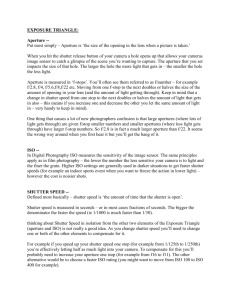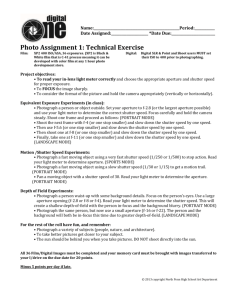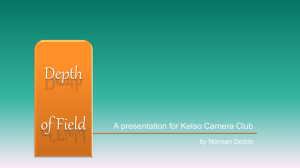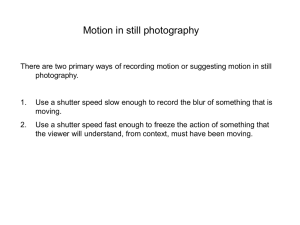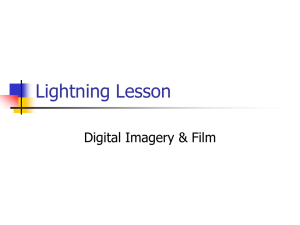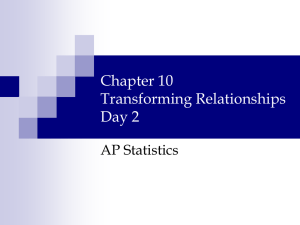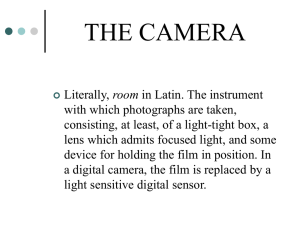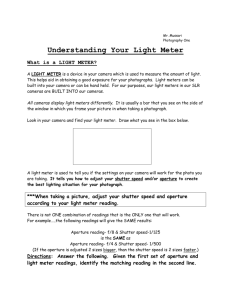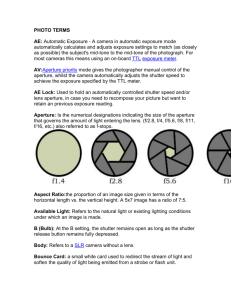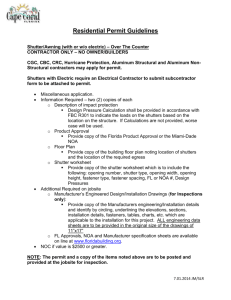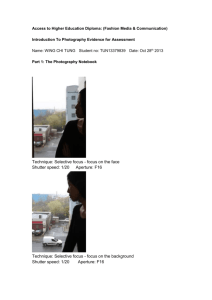3_Aperture & Shutter Speed
advertisement
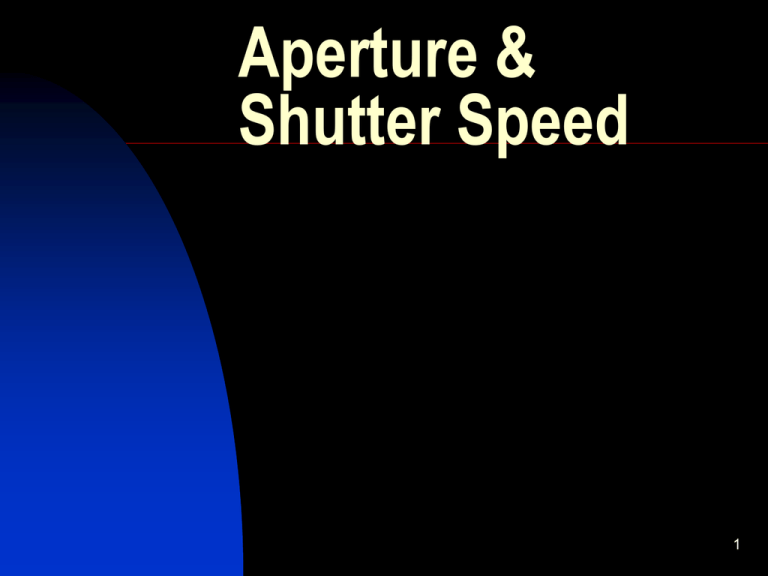
Aperture & Shutter Speed 1 Exposure To determine the correct exposure for your negative, you will need to know the correct combination of Aperture & Shutter Speed to produce a properly balanced negative. 2 Aperture Affects light and depth of field 7 standard f/stops: f/22, f/16, f/11, f/8, f/5.6, f./4, f/2.8 A larger aperture has a small number and a smaller aperture has a larger number When the aperture is opened up one stop, the amount of light doubles; when it is closed down a stop, the amount of light is halved. 3 Shutter Speed Affects light and motion Controls light by the amount of time it remains open Each number represents a fraction of a second (or a full second) Each Shutter speed is a 1 f/stop change Remember the double/half relationship It is important to your understanding of photography! 4 Shutter Speed The relationship between each shutter speed will increase or decrease the light falling on the film by a factor of 2. Example # 1: If a shutter speed of 1/125 is increased to a shutter speed of a 1/250 it will decrease the light falling on the film by one half. 5 Shutter Speed cont’d Example #2: If a shutter speed of 1/125 is decreased to a shutter speed of a 1/60 of a second it will double the amount of time light hits the film. Either multiply or divide the speed by 2 to determine how much light is entering the camera at any aperture opening. 6 Shutter Speed Cont’d Eleven standard shutter speeds found on camera: 1 sec., ½ , ¼, 1/8, 1/15, 1/30, 1/60, 1/125, 1/250, 1/500, 1/1000 Shutter speed can either blur or freeze motion The slowest shutter speed recommended for hand-holding a camera without blur is 1/60 (for a 50mm lens) The recommended shutter speed for freezing action is 1/500 The recommended shutter speed for 7 panning is 1/30 Depth of Field Range of acceptable focus (in front of, behind and around the subject in which the camera is focused) The area of acceptable focus moves from the focus point 1/3rd toward the camera and 2/3rd away from the focus point: QuickTime™ and a decompressor are needed to see this picture. 8 3 Factors that Affect DOF Aperture Focal length of lens Distance between camera and subject 9 DOF cont’d •Increasing aperture (low f/stop) decreases DOF •Decreasing the aperture (high f/stop) increases DOF 10 DOF cont’d Shorter lens focal length will have more DOF The greater the shooting distance, the more DOF 11 DOF Cont’d To isolate a subject such as a flower, use a smaller f/stop (such as f/2.8) The shallow DOF will cause the foreground subject to be in focus and the background to be blurred, giving your subject emphasis. This is called selective focus 12 DOF Cont’d To bring the entire scene into focus, use a larger f/stop (such as f/22) 13 Reciprocity or Equivalent Exposures The correlation between shutter speed and aperture is direct. Both the aperture and shutter speed control the amount of light reaching onto the film. Both double or half the amount of light, which means you can FREELY interchange the settings on shutter speed and lens opening for respective effects while retaining your preferred exposure setting. 14 Reciprocity or Equivalent Exposures For example, the photographer may prefer to make his sunny-16 shot at an aperture of f/5.6 (to obtain a shallow depth of field). As f/5.6 is 3 stops greater than f/16, with each stop meaning double the amount of light, a new shutter speed of (1/125)/(2·2·2) = 1/1000 is needed. 15
